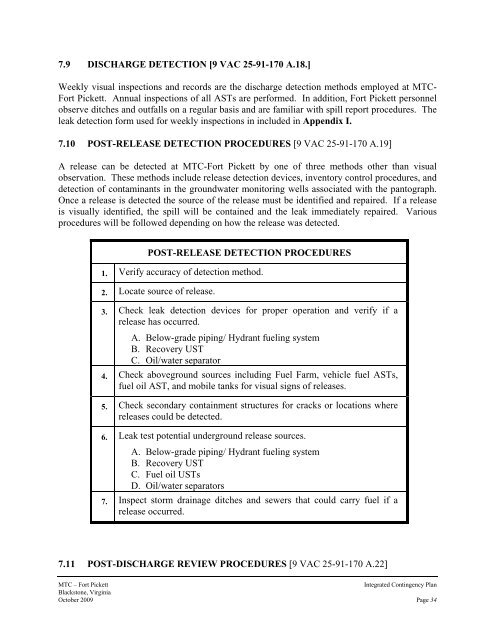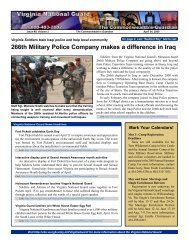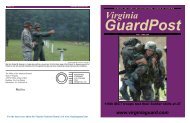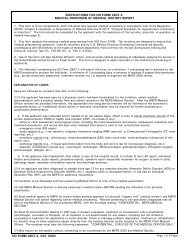INTEGRATED CONTINGENCY PLAN Maneuver Training Center
integrated contingency plan maneuver training center fort pickett ...
integrated contingency plan maneuver training center fort pickett ...
- No tags were found...
Create successful ePaper yourself
Turn your PDF publications into a flip-book with our unique Google optimized e-Paper software.
7.9 DISCHARGE DETECTION [9 VAC 25-91-170 A.18.]<br />
Weekly visual inspections and records are the discharge detection methods employed at MTC-<br />
Fort Pickett. Annual inspections of all ASTs are performed. In addition, Fort Pickett personnel<br />
observe ditches and outfalls on a regular basis and are familiar with spill report procedures. The<br />
leak detection form used for weekly inspections in included in Appendix I.<br />
7.10 POST-RELEASE DETECTION PROCEDURES [9 VAC 25-91-170 A.19]<br />
A release can be detected at MTC-Fort Pickett by one of three methods other than visual<br />
observation. These methods include release detection devices, inventory control procedures, and<br />
detection of contaminants in the groundwater monitoring wells associated with the pantograph.<br />
Once a release is detected the source of the release must be identified and repaired. If a release<br />
is visually identified, the spill will be contained and the leak immediately repaired. Various<br />
procedures will be followed depending on how the release was detected.<br />
POST-RELEASE DETECTION PROCEDURES<br />
1. Verify accuracy of detection method.<br />
2. Locate source of release.<br />
3. Check leak detection devices for proper operation and verify if a<br />
release has occurred.<br />
A. Below-grade piping/ Hydrant fueling system<br />
B. Recovery UST<br />
C. Oil/water separator<br />
4. Check aboveground sources including Fuel Farm, vehicle fuel ASTs,<br />
fuel oil AST, and mobile tanks for visual signs of releases.<br />
5. Check secondary containment structures for cracks or locations where<br />
releases could be detected.<br />
6. Leak test potential underground release sources.<br />
A. Below-grade piping/ Hydrant fueling system<br />
B. Recovery UST<br />
C. Fuel oil USTs<br />
D. Oil/water separators<br />
7. Inspect storm drainage ditches and sewers that could carry fuel if a<br />
release occurred.<br />
7.11 POST-DISCHARGE REVIEW PROCEDURES [9 VAC 25-91-170 A.22]<br />
MTC – Fort Pickett<br />
Integrated Contingency Plan<br />
Blackstone, Virginia<br />
October 2009 Page 34
















